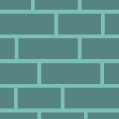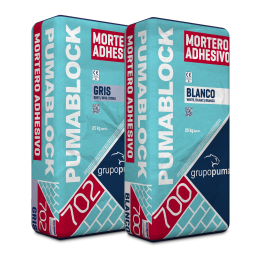 Pumablock Mortero adhesivo
Pumablock Mortero adhesivo

Thin-layer adhesive mortar for cellular concrete block manufacturing.
Additional information
Composition
Product formulated with high-strength cement, selected aggregates, and special additives.
Features and applications
- Masonry works of cellular concrete block.
- Thixotropic, easy to apply both horizontally and vertically.
- Permeable to water vapor and impermeable to rain.
- Hardens without significant shrinkage, allowing for perfect adhesion of the blocks.
Substrates
The construction elements must be dimensionally stable and solid, free from loose parts, dust, oils, and any other substances that could affect adhesion.
Instructions for use
- Add 5-6 liters of water per bag and mix manually or mechanically until a homogeneous and workable consistency is achieved.
- Lift the concrete blocks using special trowels of the same width as the wall. Apply a continuous layer approximately 3 mm thick, place the blocks, and gently tap them with a rubber mallet to ensure proper seating. This method achieves a uniform and continuous layer with a consistent thickness between 1.5 mm and 2 mm.
- To lay the next course of blocks, wait until the adhesive of the previous course has completely dried.
- Before placing each course of blocks, it is essential to verify the perfect leveling of the wall both longitudinally and transversely. If necessary, make corrections by sanding and removing dust and loose parts.
- Next, remove any mortar that oozes from the joints and level these joints as soon as possible.
- The vertical faces of interlocking blocks will not receive Pumablock adhesive mortar. However, a continuous layer of adhesive mortar should be applied at junctions between blocks with smooth faces, at right-angle joints, and at connections between cut blocks.
Cautions and recommendations
- Do not apply below 5°C or above 30°C.
- Do not apply in the presence of frost, rain, strong winds, or direct sunlight.
- In extreme weather conditions (high wind or high temperatures), drying occurs faster than normal.
- It is important not to mix Pumablock adhesive mortar with plaster, cement, sand or other construction materials.
Packaging
25 kg bags of plasticized paper.
Store for up to 1 year in the original sealed container, protected from weather and humidity.
Technical data
(Statistical results obtained under standard conditions)
| Appearance | WHITE or Gray Powder |
| Mixing time | 2 Hours |
| Compressive strength | ≥ 10 N/mm2 |
| Adhesion to the support (Block h.c) | 0.4 B |
| Water absorption by capillarity | ≤ 0.35 Kg/m2 min0.5 |
| Water vapor permeability coefficient (µ) | 5/20 |
| Classification according to UNE-EN 998-2 | M10 |
| Reaction to fire | Class A1 |
| Approximate yield | 3-6 kg/m2 (depending on block format) |
Note
The usage instructions are based on our tests and knowledge and do not imply any commitment by GRUPO PUMA, nor do they relieve the consumer from examining and verifying the products for their proper use. Claims should be accompanied by the original packaging to ensure proper traceability.
GRUPO PUMA accepts no responsibility for the application of its products or construction solutions by the applying company or other parties involved in the application and/or execution of the project. GRUPO PUMA's liability is strictly limited to any damage directly and solely attributable to the supplied products, whether individual or part of systems, due to manufacturing defects.
In any case, the project designer, technical director, or responsible party for the project, or alternatively, the applying company or other parties involved in the application and/or execution of the work, must ensure the suitability of the products by considering their characteristics, as well as the conditions, support, and potential issues of the project in question.
The values of GRUPO PUMA's products or construction solutions, as determined by the UNE standard or any other applicable regulations, refer exclusively to the conditions expressly stipulated in those standards. These include specific characteristics of the support, moisture and temperature conditions, among others. These values are not applicable to tests conducted under different conditions, in accordance with the explicit provisions of the relevant regulations.